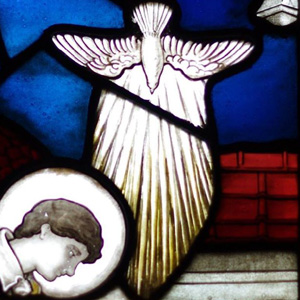This sermon was preached at Saint Oswald’s Parkside by the Revd Canon Bill Goodes on Thursday, 13 May 2021. (Ascension)
Click here to view the readings in full at the Vanderbilt Common Lectionary
“This Jesus who has been taken up from you into heaven, will come in the same way as you saw him go into heaven” Acts 1:11
Above the high altar, beautifully carved by Herr Hans Mayr in Oberammergau, stands the figure of the Risen Christ, in an attitude of revealing and welcome, the wounds of crucifixion evident in hands and side. This figure stands as the sign of the appearances of the Risen One to his friends during the days of the Easter Season.
Today, Ascension Day, marks the last of those bodily appearances to his disciples. Luke is particularly keen to emphasize that this is final — in both the last verses of his Gospel, and these opening verses of Acts Jesus is shown physically disappearing from their sight. In the Gospel it says, “while he was blessing them, he withdrew from them and was carried up into heaven”, while here in the Acts passage, “he was lifted up, and a cloud took him out of their sight”. It is this passage which has inspired a number of visual representations of the Ascension, which have a pair of feet protruding from the bottom of a cloud!
As we mark this final appearance, we should be very aware of Jesus’ parting instructions to his friends. Farewell speeches are often most revealing — making clear what has been the experience that has brought people to this day, and what has been the driving purpose behind all that has gone on. During the Easter season we have spent quite a little time studying the farewell conversations in John’s gospel, there set in the context of the Last Supper. That is really that Gospel’s account of Jesus’ farwell message. Matthew and Luke place the farewell speech at the end of their accounts. these are more concise that the four chapters of John, but make clear what Jesus wants to leave his disciples with.
Matthew contains this in four verses. He first assures the disciples of his own God-given authority, “All authority in heaven and on earth has been given me”. Then comes their commission as his witnesses: “Go and make disciples of all nations, baptizing them in the name of the Father and of the Son, and of the Holy Spirit”. Finally comes the assurance of his continued presence with them, though in the new, unseen way: “Remember, I am with you always.”
Luke picks up both of those themes, but adds that Jesus “opened their minds to understand the scriptures” — and of course that means the way the Hebrew scriptures contained enough hints to convince them that Jesus’ life, death and resurrection were all part of God’s grand plan that began with the call of Abraham. Jesus’ continued presence with them is focussed on the coming of the “power from on high” for which they were told to wait in Jerusalem. Jesus blesses his friends, and after he has withdrawn from them, they worship him, and return to Jerusalem with great joy, and are “continually in the temple blessing God”.
Now I am sure you are wondering why I haven’t mentioned tonight’s Gospel, from Mark. It is generally accepted by biblical scholars that Mark’s gospel, as attested by the oldest and most reliable manuscripts, ends in that deeply unsatisfactory way where the women returning from the empty tomb “say nothing to anyone, because they were afraid”. Some scholars suggest that someone had torn the final page off the scroll of this Gospel —”there must have been a more satisfactory ending than this!” But most now agree that this unsatisfactory place is where the writer wanted us to stand. Subsequent people, though have tried to supply a “better” ending — using material (and language) from other sources. Today’s Gospel comes from what is known as “the longer ending” of Mark, and reveals a much more “developed” idea of the significance of the Ascension than the other Gospels. In these verses there is the claim that faith and baptism are the essential items in the process of salvation. There is the assurance that those who have faith in Jesus will be able to do remarkable signs. Then there is the revelation that Jesus moves from being with the disciples straight to a seat at the right hand of God.
So we stand here today, noting that in spite of our fervent faith, we are not going to see the risen Christ as those earliest disciples did for a time (Luke is the one who limits that time to 40 days!) but we are participants with them of the promise, the commission, and the actions that accompanied that final appearance to the disciples. Jesus is with us always. We are sent out to proclaim the gospel and to baptize in God’s name, and we are called to be “continually in the temple, blessing God”!
